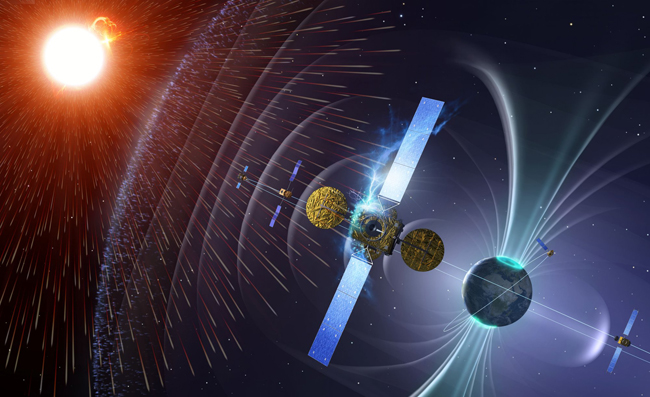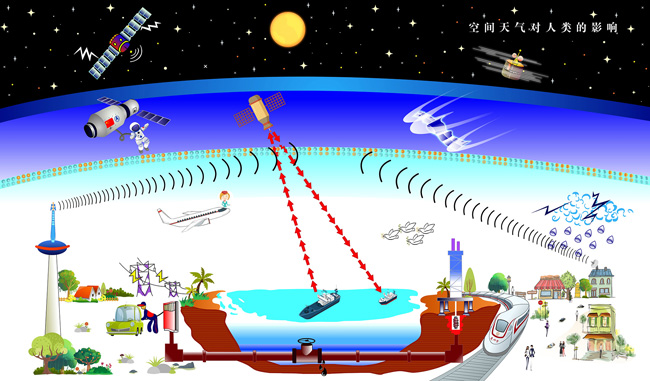
How does this year’s World Meteorological Day theme, the Sun, the Earth and the Weather link to space weather? How will space weather exert impacts on our lives? The reporter interviewed Mr. Xue Bingsen, chief forecaster from National Center for Space Weather, China Meteorological Administration.

Space weather concept diagram Source: National Center for Space Weather
Reporter: why is called space“weather”? will weather phenomena like wind, rain, or lightning happen when it comes to space weather?
Xue Bingsen:Space weather was proposed by American space physicist, Dr. M. Dryer in the precept of solar activity observation and prediction in the early 1970s.
Space weather is a far cry from the weather phenomena within planetary atmosphere. Space weather studies the physical status and processes from the sun to the immense space above earth’s troposphere. It covers phenomena like space plasma, magnetic field and radiation. Space weather is commonly associated with near-earth space magnetosphere, as well as solar and interplanetary space. Processes like solar eruption, magnetic storms, and ionosphere storms will appear. Therefore, we call it space weather.

Impacts of space weather on human beings Source: SSA
Reporter: space weather change is attributable to solar change?
Xue Bingsen: Yes. Space weather exists between the earth and the sun. Space weather change springs from solar activity. Intense activities like solar flares and coronal mass ejections on the Sun will exert grave impacts on upper air atmosphere, and ionosphere.
Reporter: how will space weather affect our daily lives? What events in our daily life is triggered by space weather?
Xue Bingsen: space weather correlates with human existence and development.
When solar storms erupt, they will affect telecommunication, compromise normal operation of satellites, lead to GPS navigation error, damage ozone layer, and will influence human health under some circumstances. Abrupt changes of geomagnetic field (magnetic storm) will wreck electric transmission system and underground pipes. Astronauts may be susceptible to injury or death when bumping into particle rains.
In recent years, National Satellite Meteorological Center (NSMC) of China has also rolled out carrier pigeon flight index forecast. It produced environmental forecast index affecting carrier pigeon flight targeted at the impacts of solar activity on the earth, namely geomagnetic activity conditions forecast.
Reporter: what are the frequency and intensity of space weather events? Are the effects all negative?
Xue Bingsen: space weather events of varying degrees and scale of impacts happen almost every year worldwide. Space weather disturbance intensity is diverse as well. Stronger ones will exert disastrous impacts. Normally, strong space weather events often happen in solar activity peak years and descend periods. Once disastrous weather occurs, huge losses may follow.
Reporter: what does space weather forecast do?
Space weather prediction releases warning and forecasting of key factors of solar activity, interplanetary space, magnetic layer, ionosphere, and the middle and upper atmosphere based on observation data and prediction models.
Research and technological breakthroughs in the space weather sphere mainly focus on whether the sun has active regions, how large they are, how they change in terms of structure and forms, and whether light radiation emitted is normal.
NSMC, CMA, mainly releases operational products via its official website, which include myriad categories of products like forecasting, monitoring, and space weather reports, and serve departments like satellite launch in China, in-orbit satellite security, satellite return security, manned space activity security, ground technical system security, navigation, and telecommunication.
Reporter: how do you interpret this year’s theme from the angle of space weather?
Xue Bingsen: space weather and traditional meteorology are situated over varied strata but are balanced by the Sun. While the Sun falls in the category of space weather research, and space weather research and observation should be further consolidated. Relevant studies and observation should strive to find out solar physical processes and key parameters affecting meteorology, and provide support for meteorological and climate forecast from the angle of energy input.
Furthermore, troposphere is the lower surface of space weather; especially in terms of near-earth space environment, weather processes impacts should be considered; study impacts of space weather factors on local weather, like the relation between cosmic rays and cloud volume.
Thirdly, deep analysis of long term statistics relationship of space weather factors and climate, to provide assisted forecast and analysis approach for disastrous climate processes.
Reporter: Su Jiexi
Editor: Liu Shuqiao